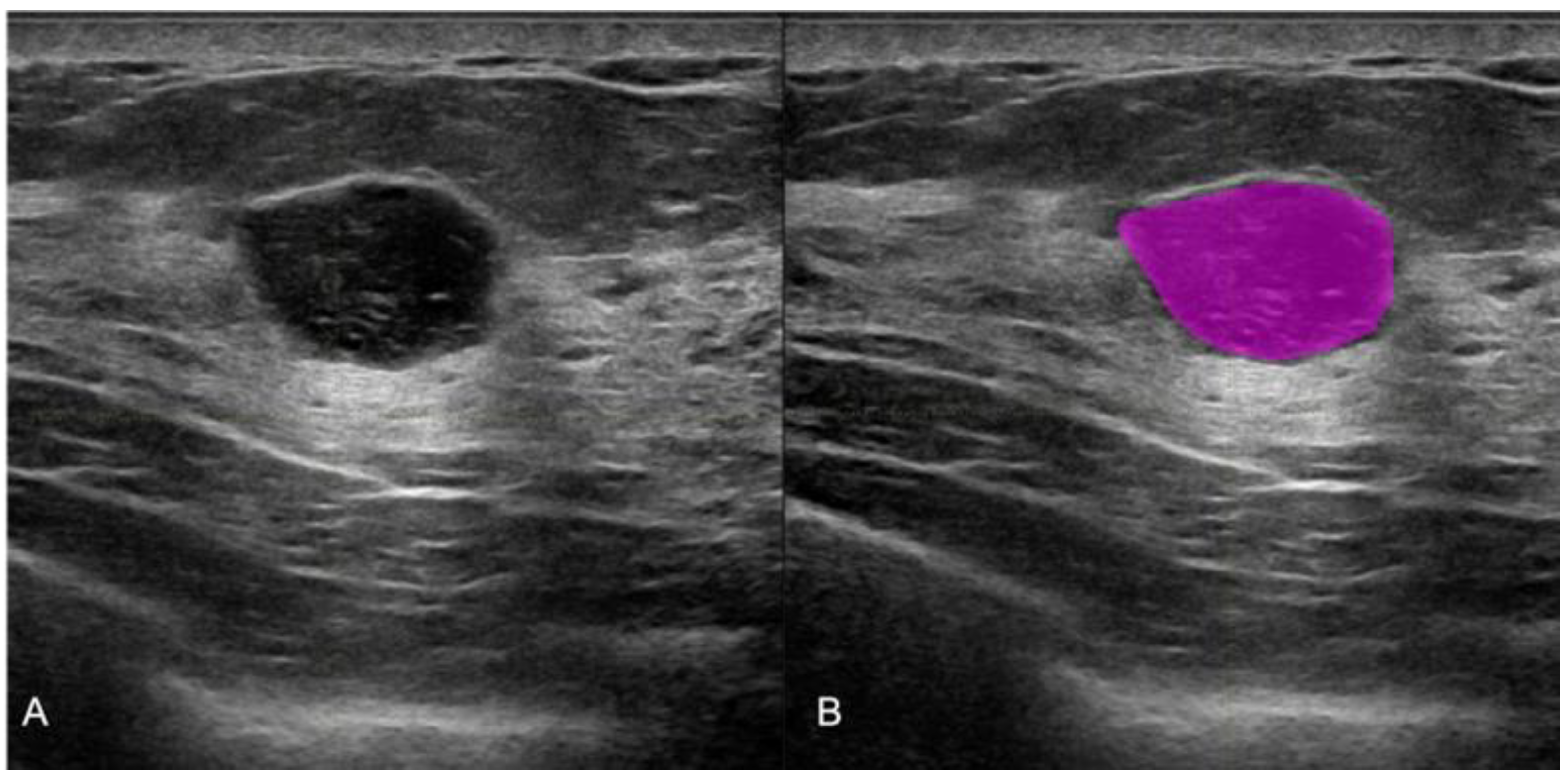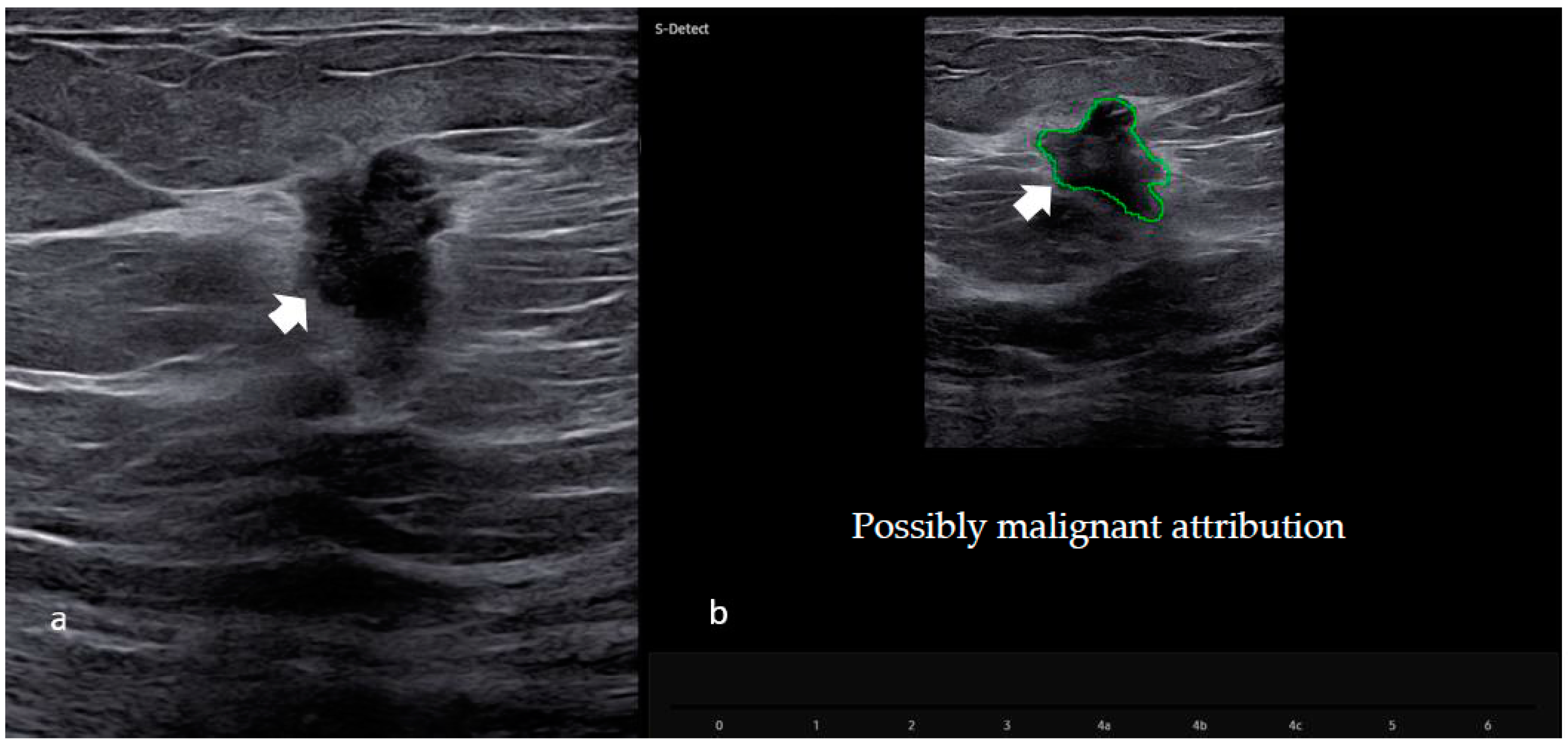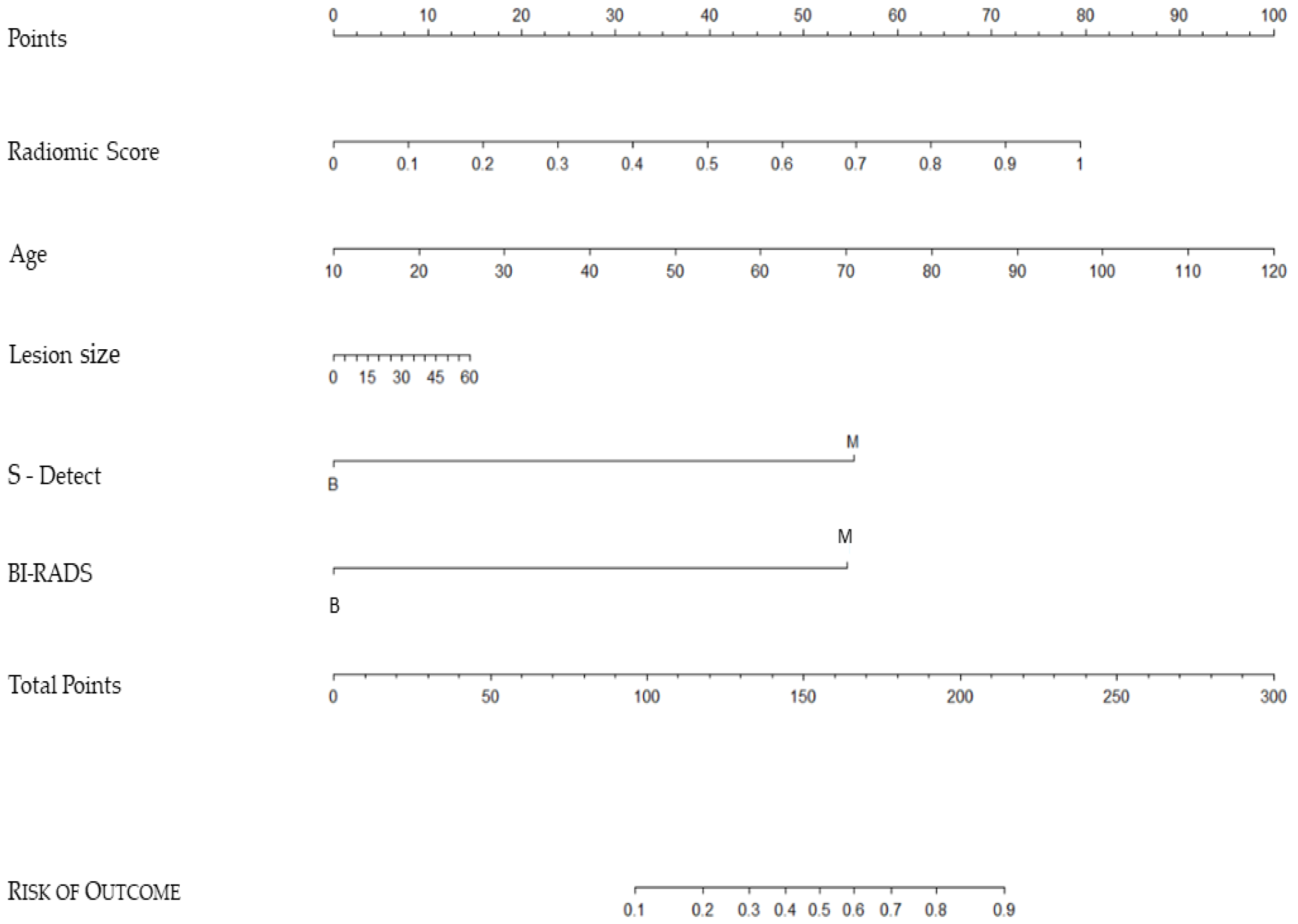Prediction of the Malignancy of a Breast Lesion Detected on Breast Ultrasound: Radiomics Applied to Clinical Practice
Abstract
:Simple Summary
Abstract
1. Introduction
2. Materials and Methods
Statistical Analysis
- -
- The radiomic model including the radiomic score (calculated with LASSO logistic regression, as described above) as a single covariate;
- -
- The Adjusted Radiomic model including the radiomic score and the clinical variables as covariates. We included here the clinical variables associated with malignancy prediction in univariate logistic regression analysis.
- -
- The Adjusted Radiomic + BI-RADS best model including the radiomic score, the best BI-RADS, and the clinical variables as covariates. For the subgroup of patients with information on S-detect, we also calculated:
- -
- The Adjusted Radiomic + S-Detect model including the radiomic score, the S-detect score, and the clinical variables as covariates;
- -
- The Adjusted Radiomic + S-Detect + BI-Rads best model including the radiomic score, the S-detect score, the best BI-RADS, and the clinical variables as covariates.
3. Results
4. Discussion
5. Conclusions
Supplementary Materials
Author Contributions
Funding
Institutional Review Board Statement
Informed Consent Statement
Data Availability Statement
Conflicts of Interest
References
- Lei, S.; Zheng, R.; Zhang, S.; Wang, S.; Chen, R.; Sun, K.; Zeng, H.; Zhou, J.; Wei, W. Global patterns of breast cancer incidence and mortality: A population-based cancer registry data analysis from 2000 to 2020. Cancer Commun. 2021, 41, 1183–1194. [Google Scholar] [CrossRef] [PubMed]
- Sung, H.; Ferlay, J.; Siegel, R.L.; Laversanne, M.; Soerjomataram, I.; Jemal, A.; Bray, F. Global Cancer Statistics 2020: GLOBOCAN Estimates of Incidence and Mortality Worldwide for 36 Cancers in 185 Countries. CA Cancer J. Clin. 2021, 71, 209–249. [Google Scholar] [CrossRef] [PubMed]
- Melnikow, J.; Fenton, J.J.; Whitlock, E.P.; Miglioretti, D.L.; Weyrich, M.S.; Thompson, J.H.; Shah, K. Supplemental Screening for Breast Cancer in Women with Dense Breasts: A Systematic Review for the U.S. Preventive Services Task Force. Ann. Intern. Med. 2016, 164, 268–278. [Google Scholar] [CrossRef] [PubMed]
- Houssami, N.; Lord, S.J.; Ciatto, S. Breast cancer screening: The emerging role of new imaging techniques as adjuncts to mammography. Med. J. Aust. 2009, 190, 493–497 28. [Google Scholar] [CrossRef]
- Tagliafico, A.S.; Calabrese, M.; Mariscotti, G.; Durando, M.; Tosto, S.; Monetti, F.; Airalda, F.; Bignotti, S.; Nori, B.; Bagni, J.; et al. Adjunct screening with tomosynthesis or ultrasound in women with mammography-negative dense breasts: Interim report of a prospective comparative trial. J. Clin. Oncol. 2016, 34, 1882–1888. [Google Scholar] [CrossRef]
- Chang, J.M.; Koo, H.R.; Moon, W.K. Radiologist-performed hand-held ultrasound screening at average risk of breast cancer: Results from a single health screening center. Acta Radiol. 2015, 56, 652–658. [Google Scholar] [CrossRef]
- Nicosia, L.; Addante, F.; Bozzini, A.C.; Latronico, A.; Montesano, M.; Meneghetti, L.; Tettamanzi, F.; Frassoni, S.; Bagnardi, V.; De Santis, R.; et al. Evaluation of computer-aided diagnosis in breast ultrasonography: Improvement in diagnostic performance of inexperienced radiologists. Clin. Imaging 2022, 82, 150–155. [Google Scholar] [CrossRef]
- Shur, J.D.; Doran, S.J.; Kumar, S.; Ap Dafydd, D.; Downey, K.; O’Connor, J.P.B.; Papanikolaou, N.; Messiou, C.; Koh, D.M.; Orton, M.R. Radiomics in Oncology: A Practical Guide. Radiographics 2021, 41, 1717–1732. [Google Scholar] [CrossRef]
- van Timmeren, J.E.; Cester, D.; Tanadini-Lang, S.; Alkadhi, H.; Baessler, B. Radiomics in medical imaging-"how-to" guide and critical reflection. Insights Imaging 2020, 11, 91. [Google Scholar] [CrossRef]
- Gillies, R.J.; Kinahan, P.E.; Hricak, H. Radiomics: Images Are More than Pictures, Tey Are Data. Radiology 2016, 278, 563–577. [Google Scholar] [CrossRef] [Green Version]
- Lambin, P.; Rios-Velazquez, E.; Leijenaar, R.; Carvalho, S.; van Stiphout, R.G.P.M.; Granton, P.; Zegers, C.M.L.; Gillies, R.; Boellard, R.; Dekker, A.; et al. Radiomics: Extracting more information from medical images using advanced feature analysis. Eur. J. Cancer 2012, 48, 441–446. [Google Scholar] [CrossRef] [PubMed]
- Kumar, V.; Gu, Y.; Basu, S.; Berglund, A.; Eschrich, S.A.; Schabath, M.B.; Forster, K.; Aerts, H.J.W.L.; Dekker, A.; Fenstermacher, D.; et al. Radiomics: The process and the challenges. Magn. Reason. Imaging 2012, 30, 1234–1248. [Google Scholar] [CrossRef]
- Limkin, E.J.; Sun, R.; Dercle, L.; Zacharaki, E.I.; Robert, C.; Reuzé, S.; Schernberg, A.; Paragios, N.; Deutsch, E.; Ferté, C. Promises and challenges for the implementation of computational medical imaging (radiomics) in oncology. Ann. Oncol. 2017, 28, 1191–1206. [Google Scholar] [CrossRef] [PubMed]
- Grossmann, P.; Stringfield, O.; El-Hachem, N.; Bui, M.M.; Rios Velazquez, E.; Parmar, C.; Leijenaar, R.T.; Haibe-Kains, B.; Lambin, P.; Gillies, R.J.; et al. Defining the biological basis of radiomic phenotypes in lung cancer. Elife 2017, 6, e23421. [Google Scholar] [CrossRef] [PubMed]
- Ganeshan, B.; Goh, V.; Mandeville, H.C.; Ng, Q.S.; Hoskin, P.J.; Miles, K.A. Non-small cell lung cancer: Histopathologic correlates for texture parameters at CT. Radiology 2013, 266, 326–336. [Google Scholar] [CrossRef] [PubMed]
- Nioche, C.; Orlhac, F.; Boughdad, S.; Reuzé, S.; Goya-Outi, J.; Robert, C.; Pellot-Barakat, C.; Soussan, M.; Frouin, F.; Buvat, I. LIFEx: A freeware for radiomic feature calculation in multimodality imaging to accelerate advances in the characterization of tumor heterogeneity. Cancer Res. 2018, 78, 4786–4789. [Google Scholar] [CrossRef]
- American College of Radiology. Breast Imaging Reporting and Data System (BI-RADS), 4th ed.; American College of Radiology: Reston, VA, USA, 2003. [Google Scholar]
- Hoon Tan, P.; Ellis, I.; Allison, K.; Brogi, E.; Fox, S.B.; Lakhani, S.; Lazar, A.J.; Morris, E.A.; Sahin, A.; Salgado, R.; et al. The 2019 World Health Organization classification of tumours of the breast. Histopathology 2020, 77, 181–185. [Google Scholar] [CrossRef] [PubMed]
- Fleiss, J.L. Measuring nominal scale agreement among many raters. Psychol. Bull. 1971, 76, 378–382. [Google Scholar] [CrossRef]
- Berg, W.A. Reducing Unnecessary Biopsy and Follow-up of Benign Cystic Breast Lesions. Radiology 2020, 295, 52–53. [Google Scholar] [CrossRef]
- Shen, Y.; Shamout, F.E.; Oliver, J.R.; Witowski, J.; Kannan, K.; Park, J.; Wu, N.; Huddleston, C.; Wolfson, S.; Millet, A.; et al. Artificial intelligence system reduces false-positive findings in the interpretation of breast ultrasound exams. Nat. Commun. 2021, 12, 5645. [Google Scholar] [CrossRef]
- Thigpen, D.; Kappler, A.; Brem, R. The Role of Ultrasound in Screening Dense Breasts-A Review of the Literature and Practical Solutions for Implementation. Diagnostics 2018, 8, 20. [Google Scholar] [CrossRef]
- Evans, A.; Trimboli, R.M.; Athanasiou, A.; Balleyguier, C.; Baltzer, P.A.; Bick, U.; Herrero, J.C.; Clauser, P.; Colin, C.; Cornford, E.; et al. European Society of Breast Imaging (EUSOBI), with language review by Europa Donna–The European Breast Cancer Coalition. Breast ultrasound: Recommendations for information to women and referring physicians by the European Society of Breast Imaging. Insights Imaging 2018, 9, 449–461. [Google Scholar] [CrossRef] [PubMed]
- Fleury, E.F.C.; Marcomini, K. Impact of radiomics on the breast ultrasound radiologist’s clinical practice: From lumpologist to data wrangler. Eur. J. Radiol. 2020, 131, 109197. [Google Scholar] [CrossRef] [PubMed]
- Gu, J.; Jiang, T. Ultrasound radiomics in personalized breast management: Current status and future prospects. Front. Oncol. 2022, 12, 963612. [Google Scholar] [CrossRef]
- Fujioka, T.; Katsuta, L.; Kubota, K.; Mori, M.; Kikuchi, Y.; Kato, A.; Oda, G.; Nakagawa, T.; Kitazume, Y.; Tateishi, U. Classification of breast masses on ultrasound shear wave elastography using convolutional neural networks. Ultrason. Imaging 2020, 42, 213–220. [Google Scholar] [CrossRef]
- Zhang, Q.; Song, S.; Xiao, Y.; Chen, S.; Shi, J.; Zheng, H. Dual-mode artificially intelligent diagnosis of breast tumours in shear-wave elastography and b-mode ultrasound using deep polynomial networks. Med. Eng. Phys. 2019, 64, 1–6. [Google Scholar] [CrossRef]
- Zhang, X.; Liang, M.; Yang, Z.; Zheng, C.; Wu, J.; Ou, B.; Li, H.; Wu, X.; Luo, B.; Shen, J. Deep learning-based radiomics of b-mode ultrasonography and shear-wave elastography: Improved performance in breast mass classification. Front. Oncol. 2020, 10, 1621. [Google Scholar] [CrossRef] [PubMed]
- Qian, X.; Pei, J.; Zheng, H.; Xie, X.; Yan, L.; Zhang, H.; Han, C.; Gao, X.; Zhang, H.; Zheng, W.; et al. Prospective assessment of breast cancer risk from multimodal Multiview ultrasound images via clinically applicable deep learning. Nat. BioMed Eng. 2021, 5, 522–532. [Google Scholar] [CrossRef]
- Jiang, M.; Li, C.L.; Chen, R.X.; Tang, S.C.; Lv, W.Z.; Luo, X.M.; Chuan, Z.-R.; Jin, C.-Y.; Liao, J.-T.; Cui, X.-W.; et al. Management of breast lesions seen on US images: Dual-model radiomics including shear-wave elastography may match performance of expert radiologists. Eur. J. Radiol. 2021, 141, 109781. [Google Scholar] [CrossRef]
- Moustafa, A.F.; Cary, T.W.; Sultan, L.R.; Schultz, S.M.; Conant, E.F.; Venkatesh, S.S.; Sehgal, C. Color Doppler ultrasound improves machine learning diagnosis of breast cancer. Diagnostics 2020, 10, 631. [Google Scholar] [CrossRef] [PubMed]
- Romeo, V.; Cuocolo, R.; Apolito, R.; Stanzione, A.; Ventimiglia, A.; Vitale, A.; Verde, F.; Accurso, A.; Amitrano, M.; Insabato, L.; et al. Clinical value of radiomics and machine learning in breast ultrasound: A multicenter study for differential diagnosis of benign and malignant lesions. Eur. Radiol. 2021, 31, 9511–9519. [Google Scholar] [CrossRef]
- Fujioka, T.; Kubota, K.; Mori, M.; Kikuchi, Y.; Katsuta, L.; Kasahara, M.; Oda, G.; Ishiba, T.; Nakagawa, T.; Tateishi, U. Distinction between benign and malignant breast masses at breast ultrasound using deep learning method with convolutional neural network. Jpn. J. Radiol. 2019, 37, 466–472. [Google Scholar] [CrossRef] [PubMed]
- Dong, F.; She, R.; Cui, C.; Shi, S.; Hu, X.; Zeng, J.; Wu, H.; Xu, J.; Zhang, Y. One step further into the blackbox: A pilot study of how to build more confidence around an AI-based decision system of breast nodule assessment in 2D ultrasound. Eur. Radiol. 2021, 31, 4991–5000. [Google Scholar] [CrossRef] [PubMed]
- Mango, V.L.; Sun, M.; Wynn, R.T.; Ha, R. Should we ignore, follow, or biopsy? Impact of artificial intelligence decision support on breast ultrasound lesion assessment. AJR Am. J. Roentgenol. 2020, 214, 1445–1452. [Google Scholar] [CrossRef] [PubMed]



| Characteristic | Overall, N = 365 | Test, N = 110 | Training, N = 255 | p-Value 2 |
|---|---|---|---|---|
| Age 1 median (IQR) | 50 (41–63) | 52 (40–65) | 50 (42–62) | 0.8 |
| Lesion size median (IQR) | 16 (12–23) | 18 (12–26) | 16 (11–20) | 0.2 |
| Histopathological category | >0.9 | |||
| Benign findings (B2) n (%) | 173 (47%) | 54 (49%) | 119 (47%) | |
| Uncertain malignant potential lesions (B3) n (%) | 11 (3.0%) | 4 (4%) | 7 (3%) | |
| In situ neoplasm (B5a) n (%) | 8 (2.2%) | 2 (1.8%) | 6 (2.4%) | |
| Invasive neoplasm (B5b) n (%) | 173 (47%) | 50 (45%) | 123 (48%) |
| Characteristic | Overall, N = 255 1 | 0, N = 126 1 | 1, N = 129 1 | p-Value 2 |
|---|---|---|---|---|
| CONVENTIONAL_std | 23.4 (20.7, 26.7) | 24.1 (20.9, 27.1) | 22.9 (20.5, 25.9) | 0.10 |
| CONVENTIONAL_Skewness | 1.10 (0.74, 1.47) | 1.16 (0.84, 1.52) | 1.07 (0.64, 1.40) | 0.015 |
| CONVENTIONAL_Kurtosis | 4.53 (3.47, 5.93) | 4.84 (3.75, 6.46) | 4.00 (3.23, 5.25) | <0.001 |
| DISCRETIZED_ExcessKurtosis | 1.02 (0.26, 2.36) | 1.44 (0.49, 2.84) | 0.73 (0.02, 2.01) | <0.001 |
| GLCM_Contrast___Variance | 6 (4, 12) | 8 (5, 13) | 5 (3, 10) | <0.001 |
| NGLDM_Busyness | 1.53 (0.74, 2.92) | 1.30 (0.58, 2.50) | 1.83 (0.83, 3.75) | 0.019 |
| GLZLM_SZE | 0.61 (0.56, 0.67) | 0.62 (0.58, 0.68) | 0.58 (0.54, 0.66) | <0.001 |
| Model | AUC (CI 95%) | Sensitivity (CI 95%) | Specificity (CI 95%) |
|---|---|---|---|
| Training—Crude 1 Radiomic | 0.773 (0.716–0.831) | 0.705 (0.619–0.782) | 0.754 (0.669–0.826) |
| Training—Adjusted 2 Radiomic | 0.842 (0.792–0.891) | 0.775 (0.693–0.844) | 0.786 (0.704–0.854) |
| Test Crude 1 Radiomic | 0.640 (0.535–0.744) | 0.660 (0.517–0.785) | 0.614 (0.476–0.740) |
| Test—Adjusted 2 Radiomic | 0.781 (0.696–0.865) | 0.736 (0.597–0.847) | 0.719 (0.585–0.830) |
| Model (Training Group) | AUC | SE | SP |
|---|---|---|---|
| Adjusted Radiomic + S-Detect | 0.887 (0.840–0.933) | 0.854 (0.771–0.916) | 0.802 (0.716–0.873) |
| Adjusted Radiomic + BI-RADS best | 0.883 (0.839–0.927) | 0.854 (0.854–0.771) | 0.764 (0.672–0.841) |
| Radiomic + S-Detect + BI-RADS best | 0.914 (0.876–0.951) | 0.854 (0.771–0.916) | 0.849 (0.766–0.911) |
| STUDY | Imaging Data and Other Combined Analyzed Data | Data Size | Radiomic Performance (AUC) |
|---|---|---|---|
| Zhang et al., 2019 [28] | B mode US + SWE | 227 | 0.961 |
| Moustafa et al., 2020 [31] | B mode US + CD + clinical data | 159 | 0.958 |
| Jiang et al., 2021 [30] | B mode US + SWE | 401 | 0.920 |
| Romeo et al., 2021 [32] | B mode US | 201 | 0.820 |
| Qian et al., 2021 [29] | B mode US + CD | 873 | 0.922 |
| Qian et al., 2021 [29] | B mode US + CD + SWE | 873 | 0.955 |
| Current study | B mode US + CAD + clinical data | 209 | 0.920 |
Disclaimer/Publisher’s Note: The statements, opinions and data contained in all publications are solely those of the individual author(s) and contributor(s) and not of MDPI and/or the editor(s). MDPI and/or the editor(s) disclaim responsibility for any injury to people or property resulting from any ideas, methods, instructions or products referred to in the content. |
© 2023 by the authors. Licensee MDPI, Basel, Switzerland. This article is an open access article distributed under the terms and conditions of the Creative Commons Attribution (CC BY) license (https://creativecommons.org/licenses/by/4.0/).
Share and Cite
Nicosia, L.; Pesapane, F.; Bozzini, A.C.; Latronico, A.; Rotili, A.; Ferrari, F.; Signorelli, G.; Raimondi, S.; Vignati, S.; Gaeta, A.; et al. Prediction of the Malignancy of a Breast Lesion Detected on Breast Ultrasound: Radiomics Applied to Clinical Practice. Cancers 2023, 15, 964. https://doi.org/10.3390/cancers15030964
Nicosia L, Pesapane F, Bozzini AC, Latronico A, Rotili A, Ferrari F, Signorelli G, Raimondi S, Vignati S, Gaeta A, et al. Prediction of the Malignancy of a Breast Lesion Detected on Breast Ultrasound: Radiomics Applied to Clinical Practice. Cancers. 2023; 15(3):964. https://doi.org/10.3390/cancers15030964
Chicago/Turabian StyleNicosia, Luca, Filippo Pesapane, Anna Carla Bozzini, Antuono Latronico, Anna Rotili, Federica Ferrari, Giulia Signorelli, Sara Raimondi, Silvano Vignati, Aurora Gaeta, and et al. 2023. "Prediction of the Malignancy of a Breast Lesion Detected on Breast Ultrasound: Radiomics Applied to Clinical Practice" Cancers 15, no. 3: 964. https://doi.org/10.3390/cancers15030964
APA StyleNicosia, L., Pesapane, F., Bozzini, A. C., Latronico, A., Rotili, A., Ferrari, F., Signorelli, G., Raimondi, S., Vignati, S., Gaeta, A., Bellerba, F., Origgi, D., De Marco, P., Castiglione Minischetti, G., Sangalli, C., Montesano, M., Palma, S., & Cassano, E. (2023). Prediction of the Malignancy of a Breast Lesion Detected on Breast Ultrasound: Radiomics Applied to Clinical Practice. Cancers, 15(3), 964. https://doi.org/10.3390/cancers15030964









